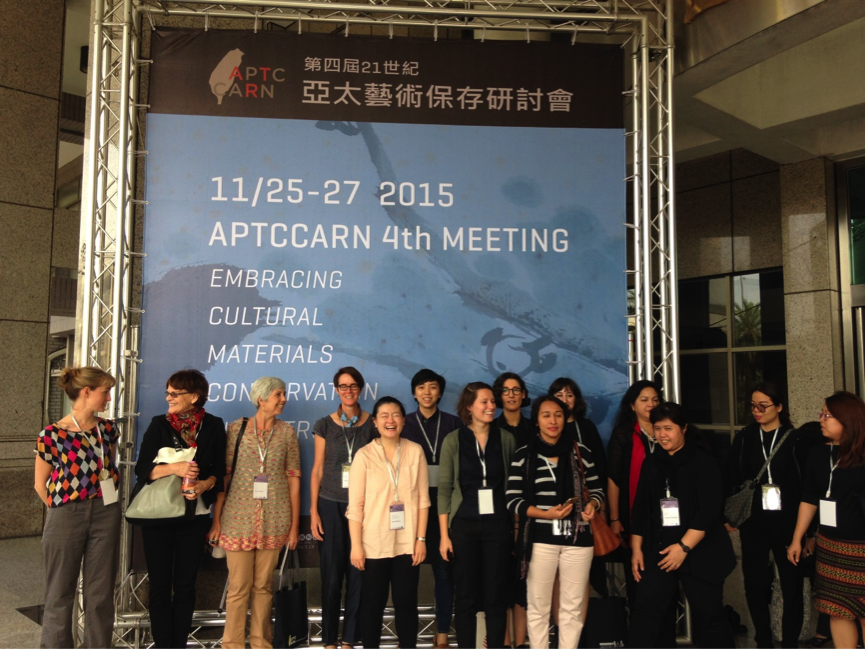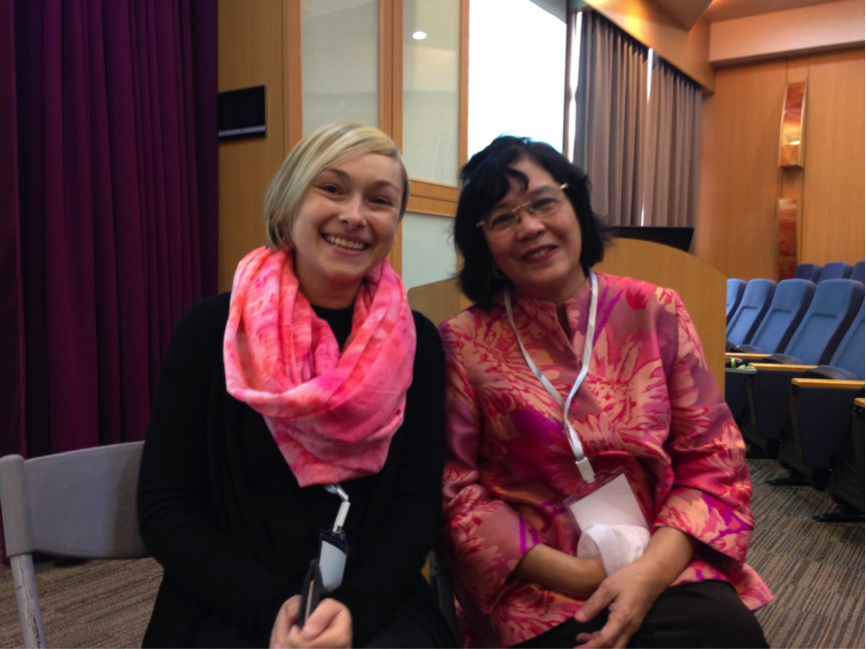Anne Carter was the recipient of the 2015 AICCM Q Grant. This is a professional development grant offered annually by the Queensland Division of the AICCM. Anne received bursary towards travel to Taiwan to present at the Asia Pacific Tropical Climates Conservation Art Research Network (APTCCARN)meeting 2015. Following this meeting Anne presented a review of the outcomes of her travel to the AICCM Queensland Division in June 2016. Here are some notes from her review.
APTCARRN was established in 2009 as a networking organization promoting collaboration in conservation research and initiatives in the Asia Pacific. This is the second APTCCARN meeting I have attended; the previous being in Bangkok in 2013.
The meeting was held in Kaohsiung City, Southern Taiwan, 25-27 November 2015, and was jointly organized by Conservation Center, Office of Art and Culture, Cheng Shiu University and the Grimwade Center for Cultural Materials Conservation, University of Melbourne. It attracted over 100 participants and was an enlightening, collegial and generous event.
The theme of the meeting ‘Embracing Cultural Materials Conservation in the tropics’ explored conservation’s interaction with cultural heritage, and the commonalities that exist among practitioners across South East Asia. A major theme that developed through the papers was the importance of local knowledge contained in traditional and community conservation practices, especially in times of development and climate change.
The meeting was introduced by Dr Rujaya Abhakoen, Director of SEAMEO SPAFA who emphasized communication and described the growing need for forums such as APTCCARN.
Dr Ioseba Soraluze, from the Cheng Shui Conservation Centre was our local host and presented on the restoration of nine paintings by Chen Cheng-po (with Li I-cheng), and provided a tour of a major exhibition of Chen Cheng-po’s work at the University.

Ioseba described his work in preparing for the exhibition, including the removal of old wax linings. His restorations included removal of varnishes that has been tinted blue by previous restorers. Later Chen Cheng-po scholar, Professor Hsiao Chong rui, provided a spectacular keynote address set to 90 minutes of classical music.
Disasters, flooding, salts and mold were repeating problems highlighted by many speakers – the ‘new normal’ as described by Dr Ana Labrador from the National Museum of the Philippines. “How prepared can you be in a disaster?” she asked, with extreme weather now a constant reality putting already at risk monument and artwork under more risk. Maximizing input from communities, volunteers and local artisans, including high school students is important for the future.
Materials, binders, paint, architecture, salts and seasonal flooding in Thailand were described in the papers of Chiraporn Aranyanark and her colleagues following devastating floods in 2011. Her work has found that different salts form at different temperatures and form a cycle – for example, Sodium Chloride is highly soluble and can penetrate substrates; Gypsum crystalizes just below the surface and causes detachment. Many of the monuments in Thailand have foundations below the water table, so urgent attention is required. Her colleague, Dr Nuanlak spoke about the great floods of 2011, and the need to understand buildings via condition modeling at different times of the year.
Chiraporn’s work also includes identifying mould types and developing treatments. She noted that collections in traditional houses are most often in better condition than in air conditioned buildings, and this dovetailed in to Dr Shin Maekawa from the Getty Conservation Institute who presented recent updates on passive climate control. His work (with assistance of a microbiologist) developed the studies of Colin Pearson and Steven King further and reiterated the importance of ventilation for maintaining a safe climate. He has a new book out, but noted that there are no guidelines yet for chemically sensitive (modern) materials.
There was a strong representation of papers from the University of Melbourne. Papers included those by Clare Grech who spoke on the effects of a tropical climate on the ageing of artists’ oil paints, Eliza O’Donnell on an investigation into painting materials of Singaporean artist Georgette Chan, 1906-1993. Eliza was staying in Kaohsiung City to undertake an internship with Ioseba for a few months, and I see from the program that she is speaking about her internship experience at October’s AICCM Paintings Group Symposium in Canberra.
Sophie Lewincamp set the mood on collaboration in a topic that was central to the meeting theme: “Painting, Mirriwoong culture and learning through materials”. This important thread was also discussed by Julia Brennan who spoke on the importance of traditional methods of creation and conservation in providing innovation and preservation solutions. Understanding culture and traditional methods is key to contemporary conservation practice and involves building trust.
Nicole Tse discussed the relevance of western knowledge to tropical climates, and the need to move beyond object based conservation models, thus to recognize objects not only for their materiality but also as repositories of stories and interpretations. She spoke of this philosophy as being the basis of the University of Melbourne Conservation course.
The strength of traditional techniques in contemporary conservation practice, combined with modern materials, was also highlighted by Lin Huan-shen, Assistant Professor at the Department of Cultural Heritage Conservation, Yunlin, Taiwan, and also by his students and colleagues. Lin Huan-shen studied in Japan for 10 years and then in China and then back in Taiwan. His interests are in Taiwanese mounting history, and in 2011 he was registered as a preserver of traditional techniques by the Taiwanese Government. He noted that paper and silk were usually framed by collectors and that traditional knowledge is best preserved in Japan. Of importance, especially in tropical climates is the traditional concept of the ‘void’ in the mounting of paper and silk – an air pocket, with a skeleton (timber), with the artwork pasted.
Papers were interspersed with fantastic lunches, events and field trips as well as tours to museums in Taipei and immersion in the culture of art, monuments, food and hospitality that is so rich in Taiwan. More information can be found at http://2015aptccarn.csu.edu.tw/

